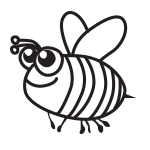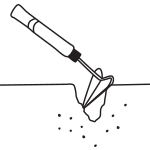
Activity 1
Flowers for pollinators
All gardeners know something about the value of bees. They may not know, however, that bee-pollinated crops constitute a large proportion of the plants we consume…

Activity 2
Flowers for beneficial insects
In a healthy and diverse garden, you would expect to see a very wide range of beneficial insects as well as the pollinating bees, wasps and flies mentioned in…

Activity 3
Activity of soil inhabitants – 1
We have prepared these plastic strips (bait lamina probes) by loading the holes in them with a special mixture which is similar to the ingredients of a dead leaf…

Activity 4
Activity of soil inhabitants – 2
This technique complements the bait lamina probe method in Section 3. The idea is that when buried in the soil, the teabag degrades at a rate dependent…

Activity 5
Soil sedimentation test
All gardeners know something about the value of bees. They may not know, however, that bee-pollinated crops constitute a large proportion of the plants we consume…

Activity 6
Soil nitrates and nitrites
This test gives an indication of soil structure, specifically the proportions of organic matter, heavy clay, light loam, sand, stones and rocks etc…

Activity 7
Soil acidity
You probably remember this from your school chemistry classes. Using these pH indicator strips will tell you how acidic or alkaline your soil is…

Activity 8
Helping plants call
for reinforcements
When a plant is damaged by an insect pest, such as a caterpillar, it does not just sit there – the wounding leads to the production of volatile chemicals…

Activity 9
The good bacteria and
fungi in the soil
As well as the tiny insects and other animals which break down dead plant material to provide nutrients, beneficial fungi and bacteria are absolutely vital…

Activity 10
Physical properties of soil
Your plants will have difficulty growing if the soil is too compact. Roots have to work much harder in that case and overall growth and productivity will suffer…

Activity 11
The value of earthworms
Earthworms play an important role in the health of soil. Their burrows improve drainage and enable oxygen to reach the roots of plants…

Activity 12
The value of birds
Most of us value having birds in and around our garden. Their songs are always welcome and seeing them and their recent fledglings in springtime…

Activity 13
Magnifying glass
This can be used for a wide range of activities. It is very helpful when you examine the bacterial and fungal growth on your plastic dishes…
How Does Your Garden Grow Kit
This unique kit is based on research carried out in the Bio-Protection Research Centre at Lincoln University in association with the Organic Biological Husbandry Unit and Kings Seeds. The kit will help you to discover a number of important things such as the acidity of your soil (slightly acid for potatoes, slightly alkaline for brassicas) and how to attract bees to your crops and ladybirds to eat your pests.
